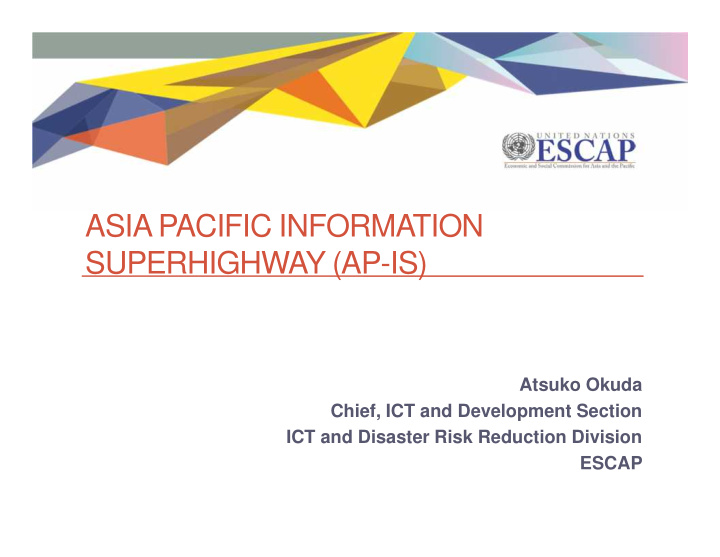



ASIA PACIFIC INFORMATION SUPERHIGHWAY (AP-IS) Atsuko Okuda Chief, ICT and Development Section ICT and Disaster Risk Reduction Division ESCAP
2 Part 1: Digital Divide in Asia and the Pacific
3 52% of broadband subscribers in Asia and the Pacific 2005 2014 Africa (0.4%) Africa (1.3%) Latin America & Caribbean (8.5%) Latin America & Caribbean (4%) ESCAP (39.9%) North America (15.2%) North America (27.7%) ESCAP (51.9%) Europe (23.1%) Europe (28%) Global shares of total fixed-broadband subscriptions in 2005 and 2014: ESCAP analysis based on 2014 ITU Figures
4 Fixed-broadband subscriptions per 100 inhabitants (average) from 2000-2014 ESCAP-LDCs, LLDCs, SIDS Fixed-Broadband Sub. per 100 Inhabitants (Average) 12 10 8 6 4 2 0 2010 2011 2012 2013 2014 Year ESCAP SIDS ESCAP LDC ESCAP LLDC ESCAP Source: Produced by ESCAP, based on data sourced from ITU World Telecommunications/ICT Indicators Database, accessed June 2015.
5 Differentiated broadband growth pattern Korea (Rep. of) Brunei Darussalam 25 Hong Kong, China 2 Fixed-Broadband Sub. per 100 (average) 2005 Fixed-Broadband Sub. per 100 (Average) 2005 20 Japan 1.5 15 Macao, China Singapore 1 10 Fiji Thailand Australia New Zealand Tonga .5 Palau 5 Malaysia French Polynesia Turkey Afghanistan Sri Lanka Viet Nam Kyrgyzstan India Indonesia Philippines Lao P.D.R. Azerbaijan Vanuatu Georgia Russia Mongolia Armenia 0 Kazakhstan 0 Micronesia (Fed. States of) Pakistan 0 10 20 30 40 0 2 4 6 8 10 Fixed-Broadband Sub. per 100 (average) 2014 Fixed-Broadband Sub. per 100 (Average) 2014 Source: Produced by ESCAP, based on data sourced from ITU World Telecommunications/ICT Indicators Database, accessed June 2015.
6 Proportionate growth between infrastructure and services ESCAP North & Central Asia ESCAP South & South-West Asia .8 .7 Kazakhstan Sri Lanka Russian Federation .6 Online Services Index Online Services Index Armenia India .6 Georgia Turkey .5 Uzbekistan Azerbaijan .4 .4 Iran (Islamic Rep. of) Bangladesh Kyrgyzstan Armenia Maldives Pakistan .3 .2 Turkmenistan Bhutan .2 Afghanistan Tajikistan 0 Nepal 0 .2 .4 .6 0 .1 .2 .3 .4 Telecommunications Infrastructure Index Telecommunications Infrastructure Index 2008 2014 2008 2014 Source: Produced by ESCAP, based on data sourced from United Nations Public Administration Country Studies/E- Government Development Index Database, accessed April 2016.
7 Strong correlation between fixed broadband subscriptions and regulatory quality index Source : Produced by ESCAP, based on data sourced from ITU World Telecommunications/ICT Indicators Database, accessed June 2015. Regulatory Quality Index sourced from World Governance Indicators, World Bank. Note: Estimates for Regulatory Quality ranges between -2 (poor regulatory quality) and +2 (very good regulatory quality); 95% Confidence Interval shaded in grey.
8 Mobile Broadband Subscriptions per 100 inhabitants growing in synch in A-P Source: Produced by ESCAP, based on data sourced from ITU World Telecommunications/ICT Indicators Database, accessed June 2015.
9 Part 2: Introduction of the Asia- Pacific Information Superhighway (AP-IS)
10 What is AP-IS? • Regional Initiative supported by ESCAP • A regional broadband network covering ESCAP Member countries and associate Member countries from Turkey to Kiribati • A pillar in ESCAP’s regional connectivity initiatives (together with transport and energy), which aims to facilitate movement of people, goods, money, information and knowledge for sustainable socioeconomic development in the region • …which addresses the causes of digital divides, develops Internet ecosystem which supports the implementation of the SDGs and stimulates digital economy
11 AP-IS Map Interactive Map, visit <http://www.itu.int/itu-d/tnd-map-public/>
12 AP-IS Programmatic View • Physical network design, • Ensuring efficient and development, effective Internet traffic management at regional and network level management at regional, sub-regional and • Inter-governmental national levels negotiation Traffic/ • Improving regulations Connectivity Network based on open access Mgmt E- Broadband Resilience for all • Bridging digital divides • Resilient ICT Networks • Promoting affordable • Support to disaster access to underserviced management systems areas • Ensuring last mile disaster • Policy and technical communication support to governments
13 Summary of Regional Status and Results High dependency on submarine Lack of IXPs and Missing, insufficient, Operational workforce not-integrated terrestrial Lack of policy awareness Physical Internet Traffic regional backbone Management Lack of open, neutral Backbone Weak domestic System Connectivity principles/practice backbone/access Vicious Cycle 80.0 Severe Tromboning Low Internet 70.0 High Cost Penetration 60.0 Fixed Low Quality 50.0 High transit cost Low demand broadband 40.0 subscriptions 30.0 Individuals Low traffic speed & high latency using the 20.0 Internet 10.0 between Int’l backbone links 0.0 Asia & Europe The Pacific Americas Fixed BB subscription * ITU 2014 (per 100 inhabitants) Individual using the Internet
14 The Way Forward • Developing AP-IS Master Plan, including goals, main activities, milestones and priorities: 2 nd meeting of the AP- IS Working Group in Aug 2016, the Committee on ICT and STI on 5-7 October 2016 • Enhancing and updating AP-IS transmission map • Facilitating private sector investment opportunities for the construction of missing fiber optic links: partnership with development banks, identifying barriers to infrastructure sharing and network deployments • Analytical work on ICT connectivity, e-resilience and digital divides • Enhanced linkage between SDGs and WSIS within AP-IS
15 Thank you Atsuko Okuda okuda@un.org
Recommend
More recommend